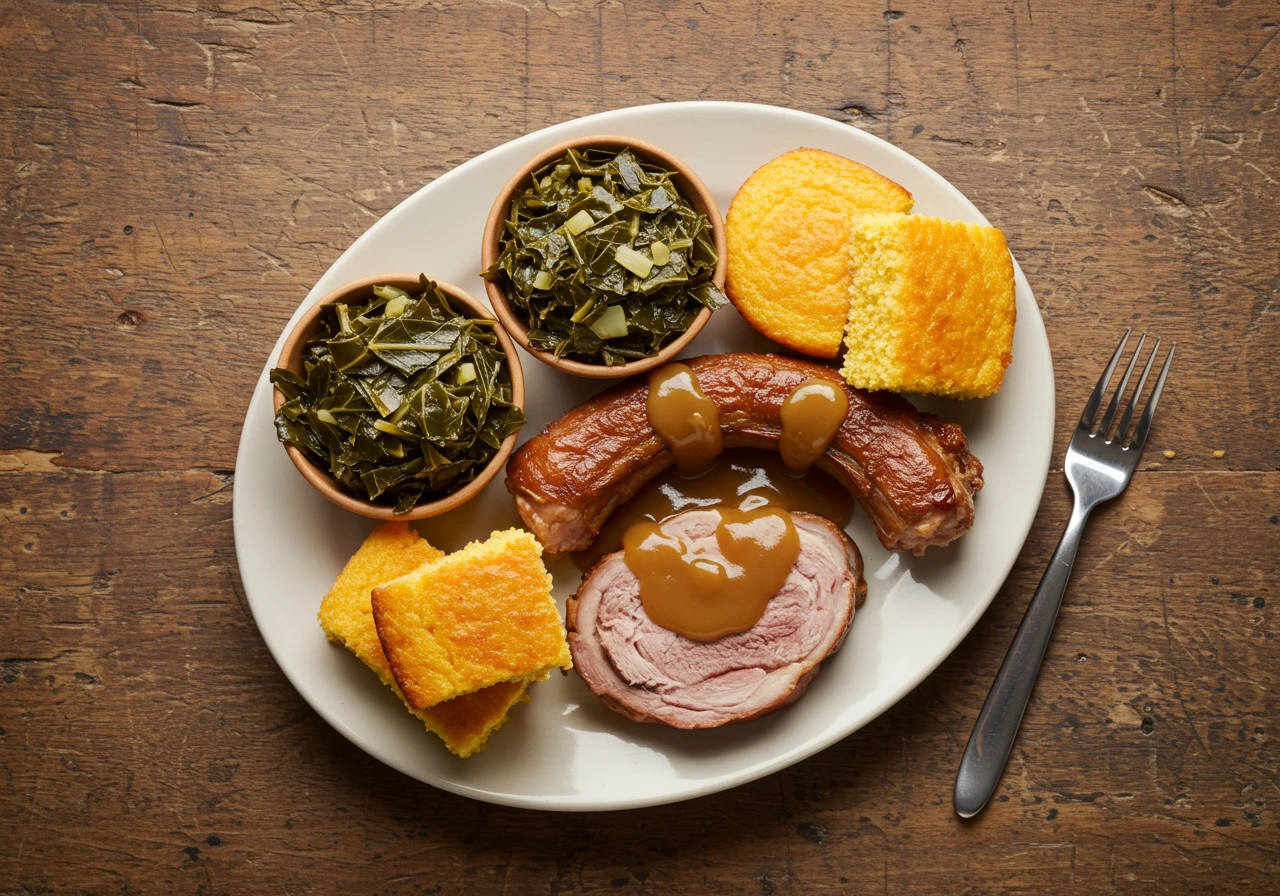Introduction
Cooking turkey necks might sound like a Southern secret or an old-school tradition tucked away in grandma’s cookbook, but trust me—they’re pure gold on a plate. These flavorful, fall-off-the-bone morsels are often overlooked in modern kitchens, yet they pack a richness that rivals more expensive cuts. This guide will walk you through everything there is to know about crafting a delicious turkey neck recipe that warms the soul.
From prep to plate, you’ll explore the different methods of cooking, seasoning secrets, and cultural variations that elevate these humble necks into hearty comfort meals. And yes, I personally tried these recipes—you’re about to get the real-deal experience with all the juicy wins and delicious lessons.
Part 1: Introduction to Turkey Neck Recipes
Why Turkey Neck Recipes Deserve a Spot at Your Table
Let’s be real—turkey necks don’t get the love they deserve. These meaty gems are often sold at a fraction of the price of other cuts, but boy, do they deliver on taste! Rich in collagen and deep poultry flavor, turkey necks are ideal for slow-cooking, smothering, or even stewing.
They’re also incredibly versatile, sliding effortlessly into a hearty stew, a Sunday gravy, or even an off-the-bone taco filling. Their affordability and flavor make them a staple in many Southern kitchens and increasingly a favorite among foodies who dig into underrated cuts.
And here’s the thing—when cooked right, the meat literally falls off the bone. If you’re looking to whip up something soul-soothing and mouthwatering, the turkey neck recipe is a must-try.
My First Time Trying a Turkey Neck Recipe
Okay, I’ll admit it—I was skeptical at first. I grabbed a pack of turkey necks on a whim (they were dirt cheap!), did a quick marinade with garlic, onions, and spices, then let them simmer with some gravy. Fast forward two hours and boom—heaven in a bowl.
I paired mine with steamed rice and sautéed greens, and the gravy? Oh, it hugged the rice like a warm blanket. The dish had this comforting vibe, like something you’d eat at your grandma’s house after a long day.
Trust me, once you try it, there’s no going back. The deep flavor, the fall-off-the-bone texture, and the way it makes your kitchen smell like a soul food dream—it’s unbeatable.
Cultural Roots and Regional Love for Turkey Neck Recipes
Turkey necks are rooted deep in Southern soul food traditions, often slow-cooked until the meat practically melts. African-American communities especially cherish these cuts, serving them during Sunday dinners or festive gatherings.
Down in Louisiana, they might be found in a spicy stew or gumbo. Jump to the Caribbean, and you’ll catch them soaking up all those jerk-style spices in a brown stew. And while these necks were once known as “poverty cuts,” today they’re prized for the very same reason—they turn simple ingredients into a meal worth remembering.
What’s more, using the whole animal is sustainable and resourceful. You’re not only getting a budget-friendly option, but also honoring traditional cooking in the most flavorful way possible.
Benefits of Cooking Turkey Necks at Home
Besides being budget-friendly and nutrient-rich, cooking turkey necks at home gives you full control over seasoning and technique. You can go full-on traditional with a smothered gravy or throw in your twist—maybe a smoky BBQ sauce or jerk-style seasoning for a modern spin.
Oh, and let’s not forget meal prepping. Turkey necks reheat like a dream and even taste better the next day as the flavors soak in deeper. Cook once, feast twice!
According to USDA’s nutrition database, turkey necks are a solid source of protein and essential minerals like iron and phosphorus. So you’re not just cooking on a budget—you’re nourishing your body with wholesome goodness.
Part 2: Understanding Turkey Necks
What Are Turkey Necks?
Turkey necks might not be the belle of the butcher’s counter, but they sure are the underdog of poultry cuts. Found just below the head, the turkey neck consists of a meaty cylindrical bone structure surrounded by layers of tender, lean meat. They’re part of the bird’s skeletal system, packed with connective tissue and small muscles that get an incredible workout—and that’s where the flavor lives.
Anatomically, they’re long, sinewy, and typically sold in segments, either whole or halved. While they may appear tough at first glance, don’t be fooled. With slow cooking, these overlooked cuts transform into fall-apart tenderness that rivals any brisket or stew meat.
Even more compelling? Turkey necks are a nutritional powerhouse. According to data from USDA and food bloggers like Momsdish, they’re loaded with protein, iron, zinc, and essential fatty acids. Oh, and they’re low-carb—keto dieters, rejoice! TikTok foodies are starting to catch on, too, showing off drool-worthy gravy-smothered dishes in viral slow-mo videos.
In the kitchen, turkey necks shine in stews, gumbos, soups, smothered dishes, and even braised over rice. The marrow from the neck bones adds richness to broths and gravies, making them ideal for cooking with purpose and flavor. You’ll find them in soul food staples, Caribbean brown stews, and even in hearty homemade stocks.
Why Cook with Turkey Necks?
Let’s face it—there are a million ways to flavor a dish, but few meats come close to the flavor intensity you get from turkey necks. Their high collagen content, when simmered low and slow, releases a rich, velvety texture that makes gravies and sauces sing. Bon Appétit describes turkey necks as the unsung hero of flavor depth, often used in fine kitchens for stocks and reductions.
Even better, they’re ridiculously affordable. You can grab a whole pound for the price of a latte, making them a go-to for budget-friendly cooking that doesn’t skimp on taste. Especially during holiday seasons when turkey sales spike, you can find necks for mere cents on the dollar. That’s a serious bang for your buck.
Now, if you’re thinking these are one-trick ponies, think again. Turkey necks are culinary chameleons. They adapt to whatever flavor profile you throw at them—be it Cajun spice, Caribbean herbs, or savory onion gravy. They’re just as at home in an instant pot as they are in a Dutch oven or pressure cooker. With endless seasoning combos and cooking methods, their versatility knows no bounds.
So, whether you’re braising, baking, or simmering, turkey necks offer a blank canvas for your creative kitchen adventures. And with the rise of slow food and soul food appreciation, they’re finally getting their flowers.
Part 3: Preparing Turkey Necks
Selecting Quality Turkey Necks
When it comes to whipping up a killer turkey neck recipe, everything starts with the selection. Freshness is key—not just for safety, but for rich, clean flavor too. So how do you pick the good ones?
First, take a look. Fresh turkey necks should have a deep pinkish-red hue with firm flesh and no foul odor. According to Epicurious and food lovers on Reddit, the meat should be moist, but not slimy. If the packaging has excess liquid or the necks look pale or grayish—hard pass. TikTok chefs often show their meat selection process, emphasizing visible muscle tone and even distribution of meat around the bone.
Wondering where to buy them? You’re not alone. You can usually find turkey necks at your local butcher, but Allrecipes and Philly Jay Cooking suggest checking international markets or the frozen meat aisle in larger grocery stores. Don’t overlook local farmers’ markets either—they often sell organic or free-range necks that are bursting with flavor. Online meat delivery services, like those on YouTube cooking channels, are also stepping up their game and shipping fresh cuts directly to your door.
So, whether you’re strolling through a local market or clicking through an online cart, choosing quality turkey necks is your first delicious step to a soul-warming dish.
Cleaning and Prepping Turkey Necks
Now that you’ve got your turkey necks, it’s time to show ’em some TLC. Prepping them properly sets the foundation for deep flavor and fall-off-the-bone tenderness.
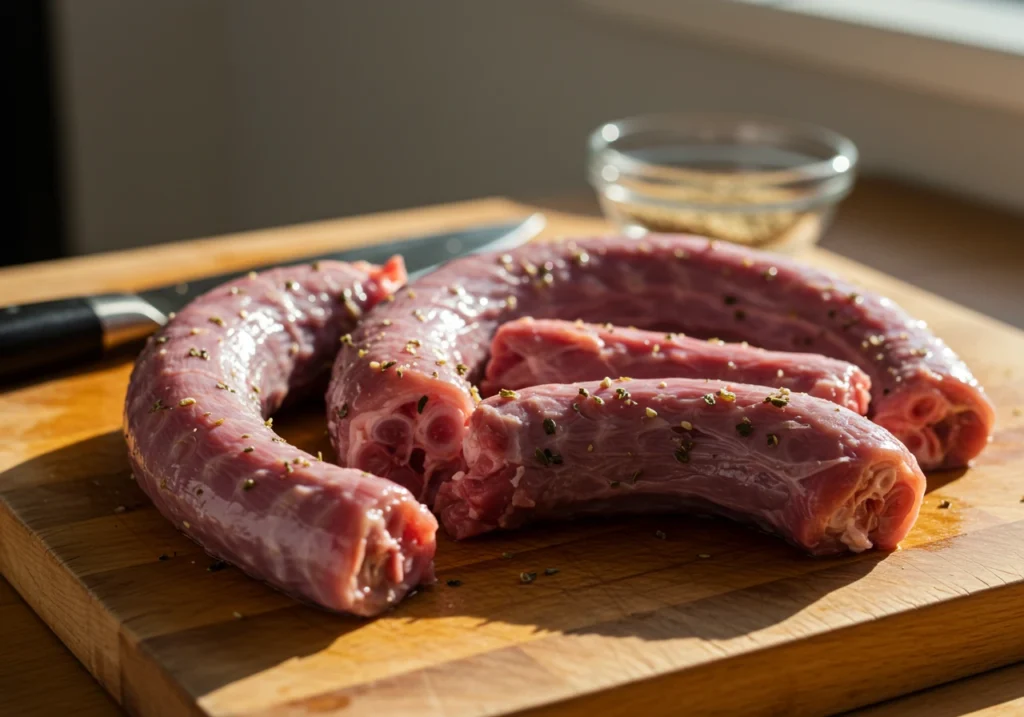
Start by giving the necks a good rinse under cool water. You’ll want to remove any bone fragments or excess fat. If there’s membrane or sinew clinging on, gently trim it off with a sharp knife. For that classic Southern approach, many home cooks—including A Girl Called Adri—recommend soaking the necks in a vinegar-water solution for about 15–20 minutes to neutralize any gamey notes. Just rinse well after soaking to remove the acidic bite.
Next up: marination. Here’s where things get interesting. A simple blend of onion powder, garlic, thyme, black pepper, smoked paprika, and a splash of oil can work wonders. Want a deeper bite? Try a dry rub overnight or even a wet marinade with Worcestershire sauce, mustard, and fresh herbs. Whether you’re baking, braising, or stewing, marination locks in flavor that’ll have your tastebuds dancing.
To amp it up even more, massage the seasoning into every crevice. Don’t just sprinkle and hope—it’s all about getting those flavors deep into the meat. Let them sit in the fridge for a few hours (or overnight if time allows), and trust me, you’ll taste the love in every bite.
Part 4: Cooking Methods
Traditional Southern Smothered Turkey Necks
When it comes to soul food classics, smothered turkey necks hold a place at the head of the table. This Southern comfort dish is all about deep flavor, tender meat, and silky gravy that clings to everything on the plate. Based on inspiration from Epicurious, A Girl Called Adri, and Bon Appétit, here’s how to bring it to life in your kitchen.
Ingredients List:
- 2.5 lbs turkey necks (cleaned and trimmed)
- 2 tbsp flour (for browning)
- 1 large onion, sliced
- 1 bell pepper, diced
- 3 cloves garlic, minced
- 2 cups chicken or turkey broth
- 1 tbsp Worcestershire sauce
- 1 tsp smoked paprika
- ½ tsp thyme
- ½ tsp cayenne pepper
- 2 tbsp oil
- Salt and pepper to taste
Step-by-Step Cooking Instructions:
- Season & Flour: Toss cleaned turkey necks with salt, pepper, paprika, and a dusting of flour.
- Brown the Meat: Heat oil in a heavy-bottomed skillet or Dutch oven. Sear the necks until golden brown on all sides.
- Sauté Veggies: Remove the necks, then sauté onions, bell pepper, and garlic until fragrant.
- Deglaze & Simmer: Pour in the broth, scrape the flavorful brown bits off the pan, add Worcestershire, thyme, and cayenne.
- Smother & Cook: Return necks to the pot, cover, and simmer on low for 2.5–3 hours or until fork-tender.
Personal Insights from Trying This Recipe:
Inspired by Kenneth Temple’s twist, I added a splash of apple cider vinegar and a dash of Creole mustard—game changer! The slow simmer infused every bite with gravy-soaked richness. This recipe took me back to my grandmother’s kitchen—pure comfort.
Oven-Baked Turkey Necks with Gravy
If stovetop smothering isn’t your thing, try oven-baked turkey necks. This method brings out a roasted depth of flavor and gives you hands-off cooking ease.
Ingredients and Preparation:
As Bon Appétit and Meiko and The Dish suggest, start with:
- 3 lbs turkey necks
- 2 tbsp olive oil
- 1 tbsp poultry seasoning
- 2 tsp garlic powder
- 1 tsp black pepper
- 1 large onion, chopped
- 2 cups water or broth
- 1 tbsp flour (for thickening)
- Optional: carrots, celery, or baby potatoes for a one-pan meal
Massage seasonings into the meat, place everything in a roasting pan, and drizzle with oil.
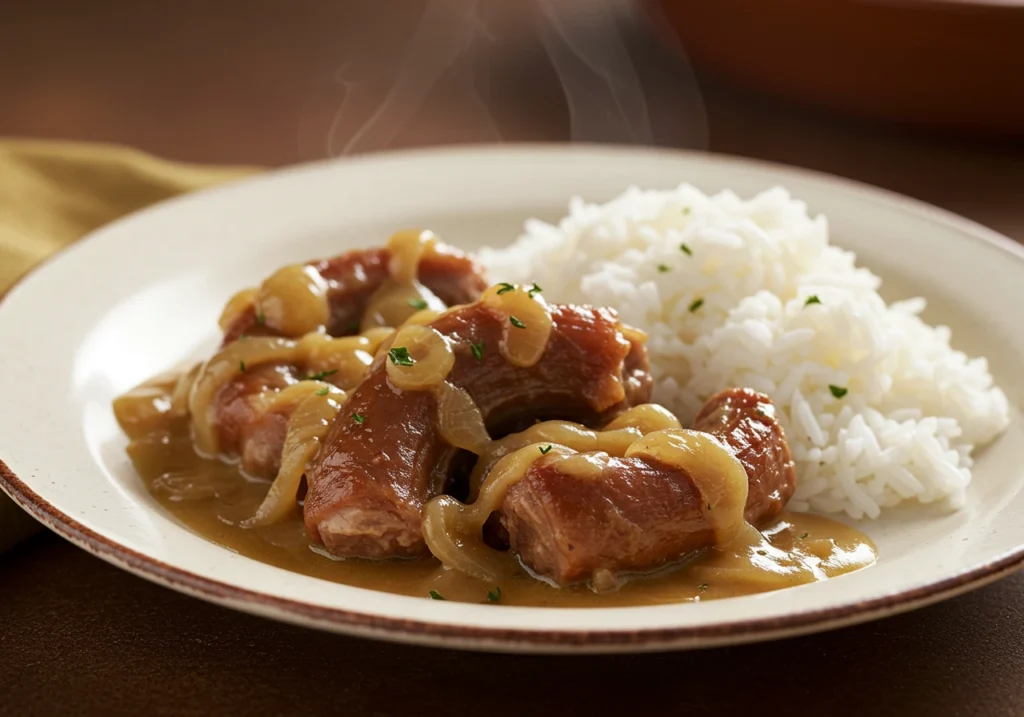
Baking Process:
Preheat oven to 350°F. Cover the pan with foil and bake for about 2.5 hours, flipping once midway. For crispy edges, uncover during the final 20 minutes. As seen on YouTube and La Cucina Italiana, this method locks in moisture while allowing the skin to lightly caramelize.
Tips for a Rich, Flavorful Gravy:
Epicurious and Momsdish both recommend using the pan drippings to make the gravy. After baking, transfer the drippings to a saucepan, whisk in a tablespoon of flour or cornstarch, and simmer until thickened. A little butter or a splash of broth can adjust the texture and taste. Kenneth Temple also suggests adding a pinch of sugar or a squirt of Dijon mustard to boost complexity.
Jamaican Brown Stew Turkey Neck
Ready for a bold Caribbean twist? The Jamaican brown stew turkey neck infuses the dish with deep island spices, fiery heat, and that unmistakable jerk flair. This style, highlighted by Epicurious and La Cucina Italiana, transforms your necks into a tropical treasure.
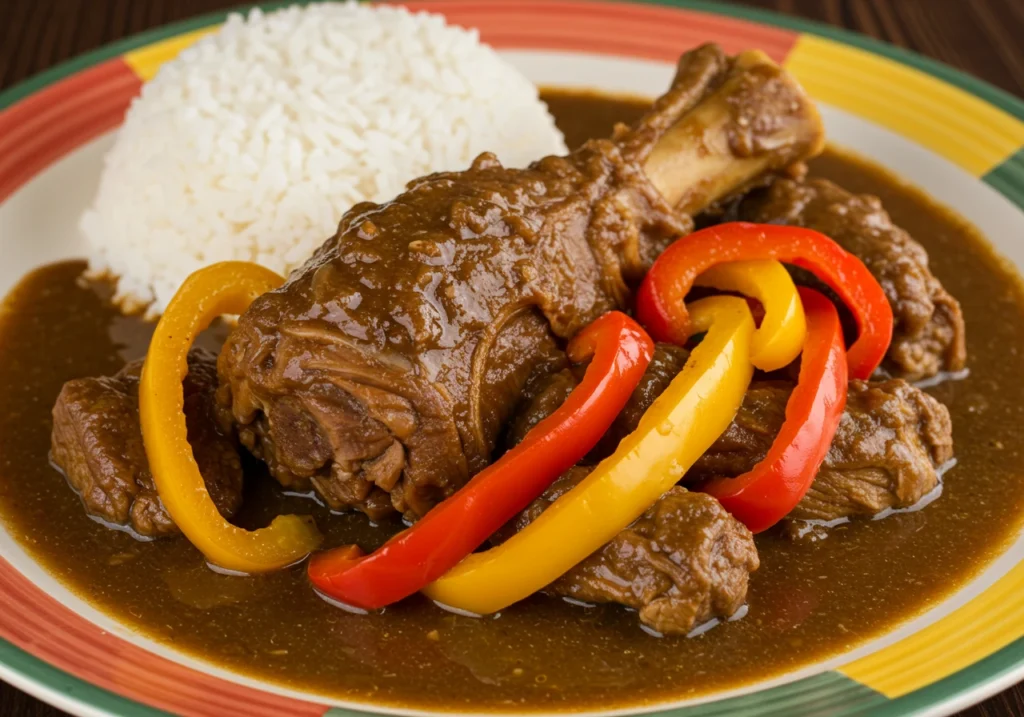
Introduction to the Caribbean Twist:
Rooted in Jamaican cuisine, brown stew turkey neck is often served in family-style meals, seasoned with allspice, thyme, and scotch bonnet peppers. It’s rich, spicy, and surprisingly easy to make.
Detailed Recipe Steps:
- Marinate necks with:
- Browning sauce
- Pimento (allspice), thyme, scallion, garlic, and scotch bonnet
- Brown Meat: Pan-sear until dark golden.
- Build Stew Base: Sauté chopped onion, tomatoes, carrots, and peppers.
- Simmer with 2 cups of water or broth for 2–3 hours, adding browning sauce and ketchup midway for color and sweetness.
Serving Suggestions:
Serve this with rice and peas, fried plantains, or roasted yams. Garnish with fresh scallions or thyme for that perfect Caribbean finish. It’s bold, it’s spicy, and it’s unapologetically delicious.
Pressure Cooker Turkey Necks
If you’re tight on time but still want that slow-cooked taste, the pressure cooker is your best friend. It takes the guesswork out of tenderness and delivers deliciousness in under an hour.
Advantages of Using a Pressure Cooker:
As shared by I Heart Recipes, using a pressure cooker means fewer hours standing by the stove. It breaks down tough muscle fibers fast, locking in all the juicy flavor while saving energy—perfect for busy home cooks.
Recipe and Cooking Times:
- Season 2–3 lbs of necks with your usual spices.
- Add to pressure cooker with 1 sliced onion, 2 cloves garlic, and 1.5 cups broth.
- Lock the lid and set to high pressure for 40 minutes.
- Natural release for 10–15 minutes for optimal tenderness.
Safety Tips:
Always ensure the vent is clear and follow the cooker’s safety lock instructions. Don’t overfill! For flavor, avoid opening too early—let the pressure do its magic.
Part 5: Serving Suggestions
Side Dishes to Complement Turkey Necks
A good turkey neck recipe deserves an equally stellar supporting cast on the plate. Whether you’re serving a traditional Southern meal or putting a modern spin on things, the right sides amplify flavor, texture, and that oh-so-satisfying “mmhmm” at first bite.
Let’s start classic. Down South, turkey necks are often paired with rice and collard greens—a combo as comforting as a warm hug on a cold day. The rice soaks up the gravy like a sponge, while the greens add a bitter bite that balances out the richness. Toss in some slow-cooked black-eyed peas, buttery cornbread, or candied yams, and you’ve got a plate straight out of a soul food dream.
But hey, don’t be afraid to modernize! For a health-conscious twist, try garlic-roasted cauliflower, creamy mashed sweet potatoes, or even quinoa pilaf infused with herbs. Want to go fusion? Serve smothered turkey necks over a bed of coconut rice or alongside roasted Brussels sprouts with balsamic glaze.
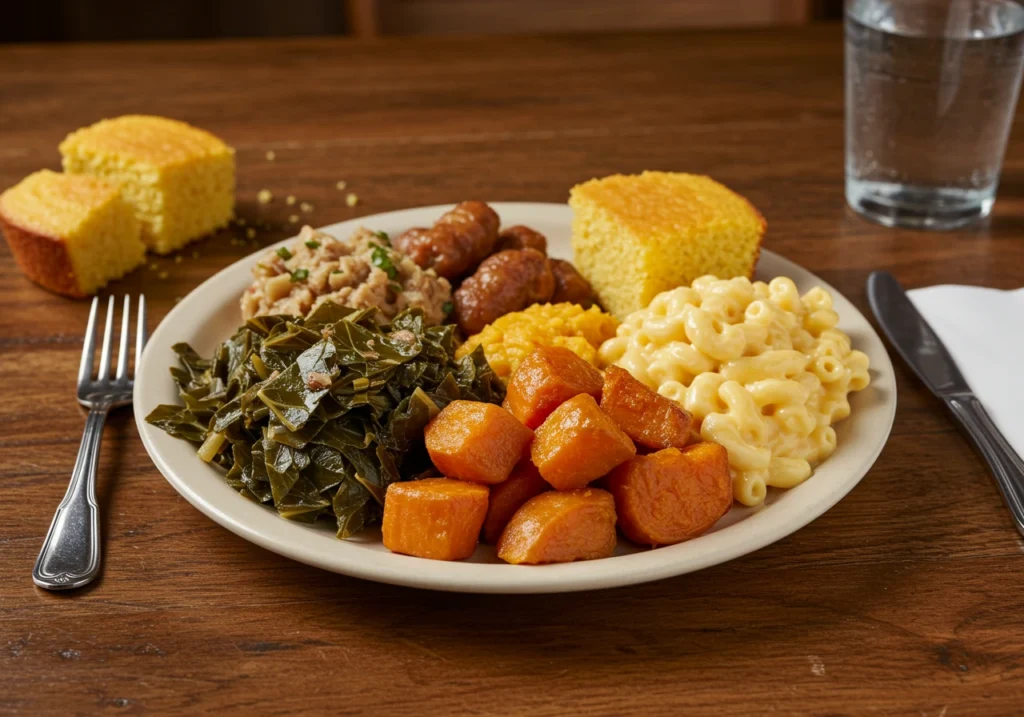
Whatever you do, remember: sides aren’t just fillers—they’re flavor multipliers. They complete the dish, round out the textures, and make the whole meal feel intentional and lovingly crafted.
Presentation Tips for an Appealing Meal
You’ve worked your magic in the kitchen—now let the plate reflect that same heart and soul.
According to A Girl Called Adri, thoughtful plating makes even rustic dishes shine. Use a wide, shallow bowl or rustic ceramic plate to allow your turkey necks and gravy to spread naturally. Don’t stack everything on top—layer flavors instead. Place rice or starch first, then gently rest the turkey necks, letting the gravy cascade over like a warm blanket.
As for garnishing ideas, a sprinkle of finely chopped parsley or green onion adds instant pop and freshness. A dash of smoked paprika or a swirl of gravy on the rim of the plate? Chef’s kiss.
On Reddit and Epicurious, food stylists suggest pairing colorful sides—like bright greens or deep-orange yams—for visual balance. Think texture, color, and contrast. After all, we eat with our eyes first, right?
Part 6: Storing and Reheating
Proper Storage Techniques
So, you’ve whipped up a pot of savory, slow-cooked turkey necks—but what about the leftovers? Don’t worry, they keep like a dream with the right care.
According to A Girl Called Adri, freshly cooked turkey necks should cool to room temperature before storing—this helps prevent excess moisture buildup and bacterial growth. Once cooled, place them in an airtight container and refrigerate within two hours. They’ll stay fresh and flavorful for up to 3 days in the fridge.
For longer storage, freezing is your best friend. Reddit home cooks and Allrecipes pros recommend separating the necks from the gravy before freezing. This prevents them from turning mushy when reheated. Use freezer-safe containers or heavy-duty freezer bags, clearly labeled with the date. Frozen turkey necks can be stored for up to 3 months without compromising too much on taste.
Here’s a tip: freeze individual portions with a bit of gravy for easy, ready-to-go meals. You’ll thank yourself on busy weeknights!
Reheating Without Losing Flavor
Reheating turkey necks can be tricky business if you’re not careful. The goal? Warm them through without turning them into rubbery leftovers.
The golden rule, according to Kenneth Temple and many Reddit chefs, is to reheat low and slow. If you’re using the stovetop, place turkey necks in a saucepan, add a splash of broth or water, and cover with a lid. Simmer on low heat for 10–15 minutes. This keeps the meat moist and the gravy luscious.
For microwave reheating, use a microwave-safe dish, add moisture (like broth or extra gravy), and cover it with a lid or wrap to trap steam. Heat in short 60-second intervals, checking and stirring in between to avoid overheating.
To avoid overcooking, steer clear of high heat settings. Remember—turkey necks are already cooked to perfection; all you’re doing is bringing that magic back to life.
Part 7: FAQs
Frequently Asked Questions About Turkey Neck Recipes
Let’s clear up the most common questions home cooks and curious foodies ask about turkey neck recipes. Whether you’re a first-timer or a seasoned soul-food lover, these answers will help you cook smarter and tastier.
What can you do with turkey neck?
Oh, the possibilities! Turkey necks are incredibly versatile. You can smother them in gravy, slow-cook them in soups or stews, braise them for a deep, rich flavor, or even toss them into your homemade broth or gumbo for that next-level savory kick. From Caribbean brown stews to pressure-cooked weeknight dinners, they adapt to nearly any recipe with ease.
Is it healthy to eat turkey neck?
Absolutely, yes! Turkey necks are packed with lean protein, essential vitamins like B6 and B12, and minerals such as iron and phosphorus. According to health-forward cooks on Reddit and platforms like A Girl Called Adri, they also contain collagen, which is great for your skin and joints. The only caveat? Keep an eye on your portion size and avoid heavy salt or butter-based gravies if you’re watching sodium or fat intake.
How long does it take to cook the neck of a turkey?
It really depends on the cooking method. If you’re slow-cooking or braising, expect 2.5 to 3 hours on the stovetop or in the oven. Using a pressure cooker? That slashes the time down to about 40 minutes. Just remember: the longer the simmer, the more tender the meat becomes. Patience is part of the flavor profile here.
How to clean turkey necks before cooking?
Start by rinsing them thoroughly under cold water. Trim off any visible fat, cartilage, or blood vessels. Many home cooks, including A Girl Called Adri, swear by soaking them in a vinegar-water solution for 15–20 minutes. This not only cleans the meat but also removes any gamey odor. Just be sure to rinse again before seasoning.

